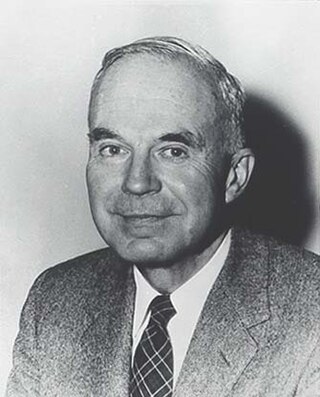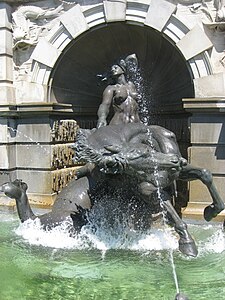
The United States Capitol, often called the Capitol or the Capitol Building, is the seat of the United States Congress, the legislative branch of the federal government. It is located on Capitol Hill at the eastern end of the National Mall in Washington, D.C. Although no longer at the geographic center of the national capital, the U.S. Capitol forms the origin point for the street-numbering system of the district as well as its four quadrants. Like the principal buildings of the executive and judicial branches, the Capitol is built in a neoclassical style and has a white exterior.

Daniel Chester French was an American sculptor in the late 19th and early 20th centuries. His works include The Minute Man, an 1874 statue in Concord, Massachusetts, and his 1920 monumental statue of Abraham Lincoln at the Lincoln Memorial in Washington, D.C.

The Jefferson Memorial is a national memorial in Washington, D.C., built in honor of Thomas Jefferson, the principal author of the United States Declaration of Independence, a central intellectual force behind the American Revolution, a founder of the Democratic-Republican Party, and the nation's third president.

Adolph Alexander Weinman was a German-born American sculptor and architectural sculptor.

James Earle Fraser was an American sculptor during the first half of the 20th century. His work is integral to many of Washington, D.C.'s most iconic structures.

The Thomas Jefferson Building, also known as the Main Library, is the oldest of the Library of Congress buildings in Washington, D.C. Built between 1890 and 1897, it was initially known as the Library of Congress Building. In 1980, the building was named in honor of Thomas Jefferson (1743-1826), a Founding Father, the principal author of the Declaration of Independence, and the third U.S. president. In 1815, the purchase of Jefferson's book collection formed a core foundation for the library's collection.

The John Adams Building is the second oldest of the buildings of the Library of Congress of the United States. Built in the 1930s, it is named for John Adams, the second president, who signed the law creating the Library of Congress in 1800. The building is in the Capitol Hill district of Washington D.C. next to the library's main building in the Capitol Complex. The Adams building opened to the public on April 5, 1939, and before being named for the president in 1980, was simply called The Annex building. It is designed in a restrained but very detailed Art Deco style and faced in white Georgia marble. It is located on Second Street SE between Independence Avenue and East Capitol Street in Washington, DC.
Donald Harcourt De Lue was an American sculptor, best known for his public monuments.

Healy Hall is a National Historic Landmark and the flagship building of the main campus of Georgetown University in Washington, D.C., United States. Constructed between 1877 and 1879, the hall was designed by Paul J. Pelz and John L. Smithmeyer, both of whom also designed the Thomas Jefferson Building of the Library of Congress. The structure is named after Patrick Francis Healy, who was the President of Georgetown University at the time.

The Peace Monument, also known as the Navy Monument, Naval Monument or Navy-Peace Monument, stands on the western edge of the United States Capitol Complex in Washington, D.C. It is in the middle of Peace Circle, where First Street and Pennsylvania Avenue NW intersect. The surrounding area is Union Square, which the monument shares with the Ulysses S. Grant Memorial, James A. Garfield Monument, and the Capitol Reflecting Pool. The front of the monument faces west towards the National Mall while the east side faces the United States Capitol.

Walker Kirtland Hancock was an American sculptor and teacher. He created notable monumental sculptures, including the Pennsylvania Railroad World War II Memorial (1950–52) at 30th Street Station in Philadelphia, and the World War I Soldiers' Memorial (1936–38) in St. Louis, Missouri. He made major additions to the National Cathedral in Washington, D.C., including Christ in Majesty (1972), the bas relief over the High Altar. Works by him are presently housed at the U.S. Military Academy at West Point, the Library of Congress, the U.S. Supreme Court, and the United States Capitol.

Roland Hinton Perry was an American sculptor and painter.
Roman Bronze Works, now operated as Roman Bronze Studios, is a bronze foundry in New York City. Established in 1897 by Riccardo Bertelli, it was the first American foundry to specialize in the lost-wax casting method, and was the country's pre-eminent art foundry during the American Renaissance.
Ezra Augustus Winter was a prominent American muralist.

Major General George Henry Thomas, also known as the Thomas Circle Monument, is an equestrian sculpture in Washington, D.C. that honors Civil War general George Henry Thomas. The monument is located in the center of Thomas Circle, on the border of the downtown and Logan Circle neighborhoods. It was sculpted by John Quincy Adams Ward, best known for his work on the statue of George Washington in Wall Street, Manhattan. Attendees at the dedication in 1879 included President Rutherford B. Hayes, Generals Irvin McDowell, Philip Sheridan, and William Tecumseh Sherman, senators and thousands of soldiers.

Albert Weinert was a German-American sculptor.

Paul Johannes Pelz was a German-American architect, best known as the main architect of the Library of Congress in Washington D.C.

The Darlington Memorial Fountain, also known as the Joseph Darlington Fountain, Nymph and Fawn, and Darlington Fountain, is a sculpture by C. Paul Jennewein atop a fountain in honor of Joseph James Darlington. It is located at Judiciary Park, where 5th Street, D Street, and Indiana Avenue NW intersect in the Judiciary Square neighborhood of Washington, D.C. The fountain is surrounded on three sides by government buildings, including the United States Court of Military Appeals, the H. Carl Moultrie Courthouse, and the former District of Columbia City Hall.

John L. Smithmeyer (1832–1908) was an American architect.

Thompson Elk Fountain, also known as the David P. Thompson Fountain, David P. Thompson Monument, Elk Fountain, the Thompson Elk, or simply Elk, was a historic fountain and bronze sculpture by American artist Roland Hinton Perry. The fountain with its statue was donated to the city of Portland, Oregon, United States, in 1900 for display in Downtown Portland's Plaza Blocks. It was owned by the City of Portland.






















